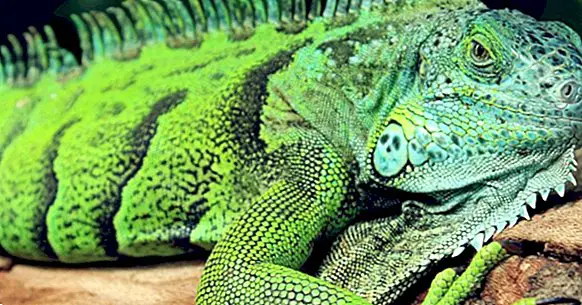Herpetophobia: symptoms, causes and treatment
Reptiles and amphibians. Along with insects, they are usually among the beings that generate the most discomfort for people. Given the danger of some of these animals, it is to a certain extent logical the existence of a certain fear towards them, being somewhat adaptive. And evidently, a run-in with a poisonous snake or a crocodile can be highly dangerous or even deadly.
But in some people, this fear is exaggerated and supposes an authentic phobia towards most reptiles and amphibians that can limit its functioning: we are talking about those who suffer an anxiety disorder known as herpetophobia .
- Related article: "Types of phobias: exploring the disorders of fear"
Defining herpetophobia
Herpetophobia is defined as the phobia or panic towards most of the reptiles and part of the amphibians . We are facing one of the most frequent specific phobias in the world, being the second most widespread phobia linked to animals, after arachnophobia.
Those who suffer from this phobia usually experience a strong anxiety in the presence of reptiles and amphibians, which may be accompanied by physiological symptoms such as tremor, hyperactivation, excessive sweating, tachycardia and hyperventilation. Exposure to these beings can generate an anxiety crisis in which pain associated with heart attacks, depersonalization or the belief that you are going to die or go crazy, among other symptoms. In some cases there may even be temporary paralysis, due to the overactivation of the nervous system . Besides fear, it is not strange that reptiles and amphibians also generate disgust or repulsion for people with this phobia.
Fear is not only aroused by the presence of these animals themselves, but also by situations or places where they might appear or by elements that announce their presence. For example, finding a snake skin can cause people with this phobia to have a panic attack. It also usually causes a certain feeling of discomfort the perception of undulating movements similar to those carried out by snakes and other reptiles . Although it is much less common, in some people may also appear fear of products derived from them or that remind them, such as clothing or accessories with scaled or simulate the skin of a crocodile or snake.
Interestingly, the fear can be more or less selective: snakes, crocodiles and toads are usually some of the greatest fear. However, other species do not usually trigger fear, such as turtles. When it comes to amphibians like toads and frogs, the problem can be found that they have some resemblance to reptiles, in addition to the knowledge that many species are poisonous.
- Maybe you're interested: "Types of Anxiety Disorders and their characteristics"
Herpetophobia and ophidiophobia: are they the same?
Herpetophobia has often been linked to the fear of snakes, considering the phobia of these beings as such. In this sense, it is often used as a synonym of ophidhophobia. But assimilating one with the other is wrong, there being no complete overlap between the two concepts.
Herpetophobia is, as we have said before, the fear of reptiles and some amphibians in general . While this includes snakes (being some of the creatures that generate more panic in people with herpetophobia), it also includes other beings such as crocodiles, lizards, iguanas, frogs and toads (these last two amphibians). That is why ophidhophobia and herpetophobia, although closely related, can not be considered synonymous. Rather, we could say that herpetophobia would include ophidhophobia, the latter being much more specific.
Why does it appear?
The cause of this phobia is not completely known, but as it happens with spiders and other creatures, a possible explanation is that the fear of reptiles is the product of the inheritance of our ancestors, assuming a fear reaction to these beings an advantage adaptive by allowing our ancestors react quickly by running away from them .
This possible inheritance would be activated by the conditioning and learning throughout life: the knowledge of people who have died after being bitten by snakes, poisoned after touching certain types of frog or eaten by crocodiles, or the fact of to suffer some type of attack on the part of some of these creatures, facilitates the fear towards them. Also, some of its characteristics, such as the high number of teeth of a crocodile or the easy view of the fangs of a snake, can themselves be disturbing.
Culture also has a role in the acquisition of this panic: traditionally, in the West, reptiles have been seen as dangerous creatures and they have been endowed with skills and related to evil, intrigue, pain and suffering. Even if we look at legends and children's stories, we often find that the obstacle or danger to overcome is a dragon or some kind of reptile. Even in religion: in Genesis the serpent is the representation of evil that tempts Eve to taste the forbidden apple. All this makes the vision of this type of animals in the West something that awakens a sense of danger in many of us.
On the contrary, in the East they are often seen as protective and benevolent entities. For example, tradition says that Buddha was protected by a naga (giant serpent-like demigods), and the image of oriental dragons is that of wise and generally benevolent and powerful beings. This contributes to the fact that the level of panic caused by these beings, although existing since the end of the day are dangerous beings, is lower.
Treatment
Specific phobias, such as herpetophobia, they have treatment from the field of psychology . It is also one of the types of disorder that is most easily treated and in which there are fewer relapses.
Although it can be more or less hard for the patient, The most applied therapy in these cases is exposure therapy . Generally applied in a gradual way, the patient will be exposed to stimuli that generate anxiety without the patient performing avoidance behaviors until the anxiety generated by them decreases.
The issue of graduation is important, given that too harsh and poorly planned exposure can actually sensitize the patient and make his fear more pronounced. Thus, a hierarchy is made between patient and therapist in which the first one will go ordering different stimuli that cause anxiety (linked to their fear of reptiles) and after that they will proceed to make the exposure from a point to negotiate between professional and client.
We must also take into account where the fear comes from: is the fear really the animals themselves, to be poisoned, to die or other aspects? Discuss what the figure of the reptiles means to the patient, because he considers that such fear exists and also value the meaning and meaning that such fear may have for the patient It is another aspect to work.
In this concrete phobia it is usual that there are somewhat distorted beliefs about the dangerousness of most of these beings or the probability of finding them. Cognitive restructuring is in these cases very useful to develop an alternative vision. However, the mere information is not enough: it is necessary to work on the subject also through the emotions that the stimulus in question triggers in the subject.



















